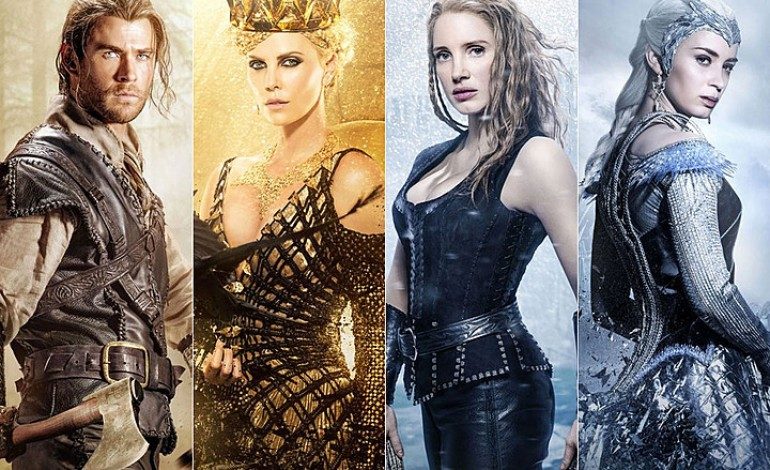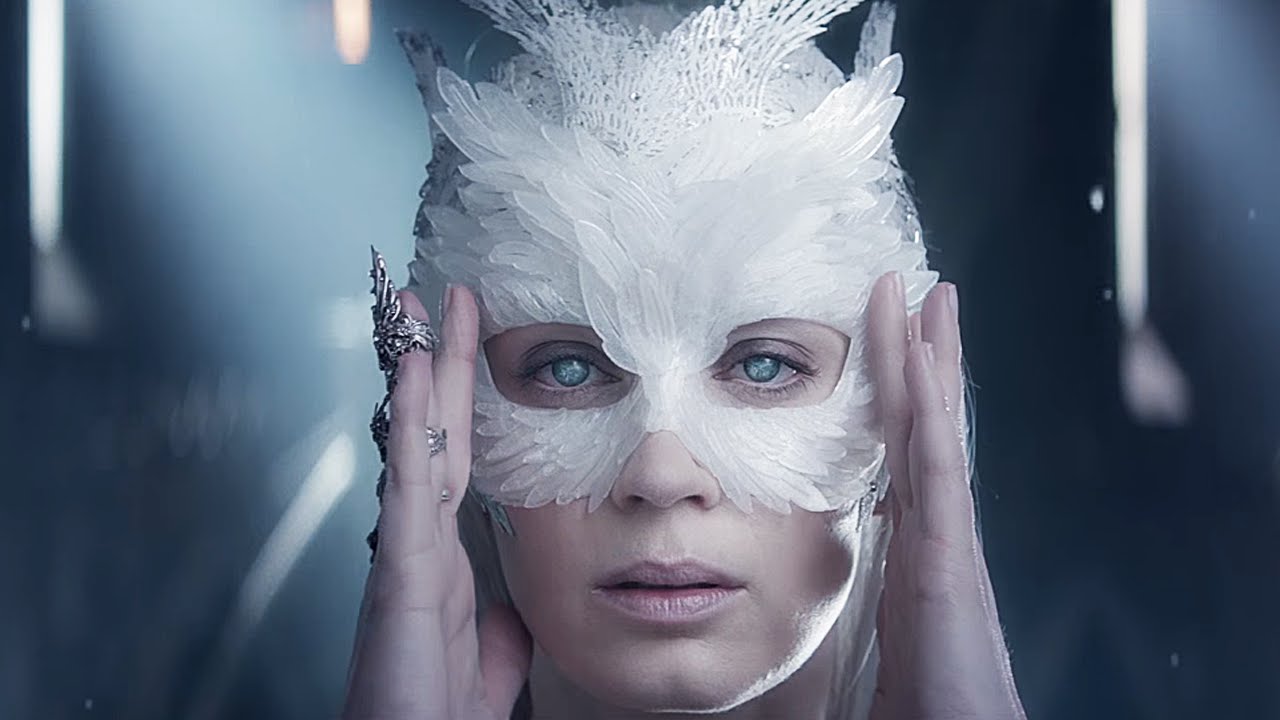

Just-Ice. Because Snow White and Winter’s War? Anyway. The Benefit of the Doubt is my segment where I look at movies that got disastrous reviews and ask “Was it really that bad?” (I have previously covered Batman v. Superman: Dawn of Justice and Fantastic Four.) This week, I focus on The Huntsman: Winter’s War. With a 16% positive, 4.2/10 average rating on Rotten Tomatoes, this fairy tale follow-up (which is part prequel and part sequel) has done significantly worse critically and commercially than its 2012 predecessor, Snow White and the Huntsman (which sits at a 48% positive, 5.6/10 average rating). But was it really that bad? And more importantly, was it worse than the original?
When it comes to The Huntsman: Winter’s War, the biggest question is: “Why?” As in, “why was this movie made?” To be sure, the 2012 original was a financial success – making nearly $400 million worldwide on a $170 million production budget (though only grossing $155 million domestically) – but numbers needn’t say everything. The film scored primarily mixed-to-negative reviews upon release and history has shown it to be among the most forgettable of our contemporary fairy tale-inspired movies. Director Tarsem Singh’s unfairly maligned other 2012 Snow White movie (Mirror Mirror) is a lot more visually impressive, a lot more audience friendly and a lot truer to the source material. For how terrible Tim Burton’s 2010 Alice in Wonderland is, at least some of its popularity made sense, in a highly disappointing way – or to put in more reasonable terms, at least its color scheme went beyond Earth tones. And Disney has successfully figured out how to transform some of their earliest animated films into modern day live action blockbusters (e.g. Maleficent, Cinderella, The Jungle Book, and many others on the way).
But Snow White and the Huntsman was an outsider. Despite its fairy tale origins, it fell victim to the late 2000s/early 2010s trend of making everything dark, gritty, and realistic – no matter how poorly it suited the source material. This Snow White came across like some low rent Robin Hood adaptation (much like the ill-executed Ridley Scott/Russell Crowe affair from two years prior). Although it was wholly unremarkable with uninspiring forest sets and a leaden script, it nevertheless put on a decent enough presentation to masquerade as a real movie.
Notably however, the film could not maintain a commitment to its promise of realism and needlessly included several fantastical elements that shattered its entire premise. It had an entirely pointless scene that ripped off imagery almost directly from Princess Mononoke and included actual fairies, who contributed nothing to the story (and still don’t, even in the sequel). Giving magical powers to the Evil Queen Ravenna (Charlize Theron) made “some” sense due to source material (though I don’t remember her ever having the ability to transform into birds), but it didn’t feel necessary. For a film that tried so pointedly to avoid the wondrous “trappings” of a fairy tale, why not simply make Ravenna jealous of Snow White either because of vanity or because she would get the throne when she became 18? It’s a testament to the movie itself that because it was was so flavorless and bland that these disparate elements didn’t clash as poorly as they might have in a movie with an actual voice.
Many, but not all, of these problems almost certainly tie back to the actual lead of the movie – Snow White herself, Kristen Stewart. I am willing to concede that the former Bella Swan has attempted to do good work since the Twilight franchise was buried. She’s taken on legitimate dramatic roles in Still Alice and the upcoming Billy Lynn’s Long Halftime Walk, won numerous awards for her supporting turn in Clouds of Sils Maria (including the prestigious César Awards), and … was woefully miscast in American Ultra. But much like co-star Robert Pattinson, she has been taking challenging and unique roles that suit her dramatic aspirations. (Taylor Lautner, on the other hand, is Adam Sandler’s protege.)
As the lead in Snow White? She was as flavorless and bland as the film itself – unable to pull off either the vulnerable ingénue at the beginning, or the strong warrior woman at the end. Stewart might have talents as an actress, but action hero is not one of them. However, one can easily argue it was her name alone coasting on the star power of Twilight that made the first movie a success. After all, it’s not like Chris Hemsworth is a guaranteed money maker, director Rupert Sanders hadn’t directed a feature before, and Charlize Theron is hit or miss.
But success is success, so Universal decided not to leave well enough alone and double down with a follow-up film. (And that worked out so well, what with the studio admitting it would need to take a write off on this movie after the first weekend of release.) But unlike many follow-up films, Snow White set the bar so low that this could have actually been an improvement. For awhile, Frank Darabont (director of The Shawshank Redemption and the man initially responsible for The Walking Dead TV series) was slated to direct, and he’s certainly a name director who could have breathed new life into the property. (He ended up being replaced by Cedric Nicolas-Troyan, another first time director, who previously served as the second unit director on Snow White and the Huntsman and Maleficent.) Stewart was out, which was simultaneously great and terrible news, and replaced with a venerable powerhouse of female leads in Emily Blunt, Jessica Chastain, and the returning Charlize Theron. And Chris Hemsworth said “sure” because he wasn’t invited to be part of Captain America: Civil War.
But, I must reiterate, it’s not like Snow White and the Huntsman gave them a lot to live up to; there was certainly potential for Winter’s to be better than the original – and it was, in some areas (while falling woefully short in others). Overall, Winter’s was more fun and livelier than the first film, which is bizarre considering how the premise involves The Ice Queen Freya (Emily Blunt) kidnapping children to raise as her army after her sister Ravenna kills her own spawn. (And that’s how The Huntsman got his skills, he’s a child soldier who escaped the clutches of Freya. How so desperately we needed that mystery solved.)
While the concept of Huntsman: Origins is frankly ridiculous, the film balances out that stupidity with several pluses. The cast is a lot better than in the first one. Emily Blunt and Charlize Theron appropriately ham it up for this ludicrous venture. Yet even by “playing to the back seats” their relationship provided an emotional crux that the original film lacked. Love interest Jessica Chastain shares a much better rapport with Hemsworth than Stewart did; she even smiled and looked like she was having a good time. (Note: Chastain plays Sara, the presumed dead wife of The Huntsman alluded to in the first movie.) And Hemsworth is allowed to be charming. While this movie also casually “homaged” a variety of other films (including Lord of the Rings, Indiana Jones, Unforgiven, The Wizard of Oz, Frozen, The Golden Compass, Return of the Jedi, to name a few), it lacked the self seriousness of the first film so the copying didn’t seem as egregious. You can forgive a lot with a movie that is knowingly hokey.
However, despite these positive elements, Snow White still has one very important thing to its advantage – it actually feels like a movie. It has a a more cohesive story, a bigger cast, and battle scenes with actual armies. The first film even had seven (technically eight) dwarfs, instead of Winter’s which only had four (two males, two females), and only one of them was a returning dwarf – Nick Frost’s character, Nion. (Come on Simon Pegg, cast him as Harry Mudd or something.)
In Snow White, we understand that the kingdom is in danger and needs to be saved from a genuine threat. It might have meandered a lot to get there (and to pad the running time to an unreasonable 127 minutes, compared to Winter’s 114 minutes) but it has a single thread. Winter’s lacks any sense of urgency, danger, or consistency. Initially, the characters have to recover the Magic Mirror – which has taken on the properties of The One Ring in Lord of the Rings – in order to destroy it. (The only time Snow White appears – played by an obvious body double – she is kneeling in front of the mirror ruing the madness slowly overtaking her.) Then the film becomes about stopping Queen Freya from conquering lands (I guess) PLUS the Huntsman winning back Sara’s heart. Moreover, those expecting major battle sequences will be disappointed; they were clearly not in the budget this go around. The film’s climax is primarily Ravenna and Freya divaing at one another while the heroes are barricaded by an ice wall.
While there is a lot of Lord of the Rings in this movie, as there will be in every fantasy franchise until the end of time, The Huntsman Saga probably owes more to the Clash/Wrath of the Titans remakes from several years back. (And not just because both Wrath and Winter feature the main character being summoned for duty after retiring/mourning his dead wife.) The first two movies of each series were gigantic spectacles that suffered from way too grandiose a sense of self importance. But even with both movies marred by horrible scripts and personality-less leads, it certainly seemed like a lot of money was thrown their respective ways with huge battle sequences, large casts, better special effects, and more locations.
However, the sequels for these movies were different from their predecessors, but in the same way. They lacked the driving plot and cinematic oomph, but in return, they gained a bit more personality. It was obvious neither follow-up had a strong plot or even the faintest reason for existing, but they were slightly more enjoyable all the same. The campiness was played up. They stopped being so damned serious. Characters got to look happy. The main character got brand new love interests. Both sequels even had robotic owl spies – Wrath bringing back Bubo from the 1980’s Clash and Freya having her own Ice Bubo in Winter’s. However, neither audiences nor critics took to the sequels nearly as well as the first ones.
Perhaps a better comparison is that these movies are practically the DLC of the film world; they’re light and feel like an afterthought. They’re not horrible experiences, but they’re certainly not essential. Unfortunately, while it might be fun continuing to explore the world of a video game, who really cares about what other creatures lurk in Snow White’s kingdom? That is what this movie never figured out.
Taken individually, Winter’s is a more pleasurable movie, but Snow feels like the most complete one. As far as overall quality goes, Winter’s is more maligned than it should be standing on its own, but it suffers heavily from the sin of never providing a reason for its existence. We are more willing to cut breaks to the first film in a franchise as it’s finding its feet and giving us “new” ideas to wrap our heads around. When it’s time for the second film, flippant and inconsequential should not be the goal. Fool me once.

